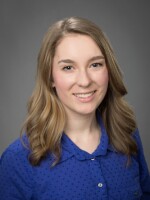On the edge of Libby Booth Elementary School grounds in the center of Reno stands a blue and white, 20-foot shipping container.
But this is no ordinary shipping container - it’s a regulatory air quality monitoring site. It has a ladder running up one side, sensors and equipment on both the roof and inside.
The pumps at the site run 24 hours a day and the instruments continually pull air samples, said Craig Petersen with the air quality management division of Northern Nevada Public Health.

The site is just one collaboration between the Washoe County School District and Northern Nevada Public Health. The two organizations also worked together to install 10 low-cost air sensors at local schools. Unlike the storage container monitoring site, these low-cost sensors are small; they can fit in the palm of your hand and are mounted on the schools’ outside walls. These low-cost sensors help address the problem of limited air quality data at local schools – including those in Cold Springs and Sun Valley – and were installed to detect smoke levels.
The regulatory monitoring station measures other pollutants related to urban areas, like ozone and carbon dioxide, in addition to measuring factors that indicate wildfire smoke, Petersen said.
“They’re giving us concentration levels for all those pollutants that we’re worried about in the public health world,” he said.
Every hour, data from the monitoring site is uploaded to AirNow.gov. A map specifically for fire and smoke information is available at Fire.AirNow.gov.
“We need to make sure that all that data is easily accessible by the public and by the community, so that they have all the knowledge and the tools to make proper decisions to protect their health,” Petersen said.
The data from the low-cost sensors allows the district to make better decisions, said Roy Anderson, the Washoe County School District’s emergency manager.

“When we’re looking at, do we need to cancel recess? Do we need to cancel school, district-wide, based on the hazardous air quality? That’s kind of how we got into the partnership with our local partners,” he said.
The low-cost sensors have been in place for about a year. Petersen and Anderson worked with their teams to decide on the location of the monitors at each school.
The monitors haven’t been used to make a determination about a smoke day yet, because there’s been significantly less wildfire smoke in the area this year. However, they are still useful to schools when the air quality does dip, even if it’s only by a moderate amount, Anderson said.
“The sensors at that point become beneficial for our coaches, our principals, to make a determination of whether or not we need to cancel practice or limit activities, or do more breaks, drink more water,” he said.
The Washoe County School District’s air quality procedures are also being noticed by school districts outside the area.
Anderson said that, when air quality was poor in Clark County or at schools in Idaho, their emergency management teams reached out to him. He was able to share what he’s learned and point them to the Washoe County School District’s online resources.
“It’s nice to have other school districts utilize the tools that we’ve developed based on our experience, rather than trying to reinvent the wheel,” he said.

To continue the collaboration, Petersen said they are working to place a full regulatory monitoring station at Verdi Elementary School, using grant funding from the Environmental Protection Agency.
Many times, the smoke seen locally is from wildfires burning in California, he said.
“Verdi is actually the closest to the California state border, and will actually see the effects of this wildfire smoke first, so it can actually serve as an early warning or an early indicator for us,” Petersen said. “So if we really see levels start spiking in Verdi first, then we can make sure that everyone downwind of that knows it’s coming.”
This reporting is part of KUNR’s fellowship with the Advancing Democracy program. It’s a solution-oriented story, looking at responses to the issue of wildfire smoke and how effective they are.
In part two of this reporting, KUNR’s Natalie Van Hoozer looks at what’s being done to provide rural communities with expanded air quality monitoring.






